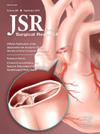A Preoperative Model for Predicting Lymphovascular Invasion in Pancreatic Ductal Adenocarcinoma
IF 1.7
3区 医学
Q2 SURGERY
引用次数: 0
Abstract
Introduction
Lymphovascular invasion (LVI) is a pathological feature associated with poor prognosis in patients with pancreatic ductal adenocarcinoma (PDAC). The objective of this study is to develop a preoperative model for predicting LVI in PDAC patients.
Methods
One Thousand and Nine patients from three tertiary hospitals were enrolled in this study. Univariate and multivariate logistic regression analyses were performed to identify independent predictors of LVI. A nomogram was constructed based on the results of the multivariate analysis.
Results
The present study identified age <65, cachexia, preoperatively assessed CA19-9 levels, lymph node metastasis reported in imaging, and increased tumor size as independent high-risk predictors of LVI in PDAC. The nomogram, incorporating these predictors, demonstrated good predictive performance in both the development and validation cohorts. The high-LVI-risk patients experienced worse recurrence-free survival and overall survival compared to their low-LVI risk counterparts. Notably, patients with high LVI risk demonstrated prolonged survival following neoadjuvant chemotherapy, whereas survival in patients with low LVI risk did not show significant extension after neoadjuvant chemotherapy.
Conclusions
A successful establishment and evaluation of a preoperative model predicting LVI in PDAC was achieved. The application of this model holds potential benefits for guiding clinical decisions regarding the utilization of neoadjuvant therapy.
预测胰导管腺癌淋巴血管浸润的术前模型
淋巴血管侵袭(LVI)是胰腺导管腺癌(PDAC)患者预后不良的病理特征。本研究的目的是建立一个预测PDAC患者LVI的术前模型。方法选取3所三级医院的1009例患者作为研究对象。进行单因素和多因素logistic回归分析以确定LVI的独立预测因子。根据多变量分析的结果构建了一个nomogram。结果本研究确定年龄(65岁)、恶病质、术前评估CA19-9水平、影像学报告的淋巴结转移和肿瘤大小增加是PDAC患者LVI的独立高危预测因素。结合这些预测因子的nomogram,在开发和验证队列中都显示了良好的预测性能。与低lvi风险患者相比,高lvi风险患者的无复发生存期和总生存期更差。值得注意的是,高LVI风险的患者在新辅助化疗后的生存期延长,而低LVI风险的患者在新辅助化疗后的生存期没有明显延长。结论成功建立并评价了PDAC术前LVI预测模型。该模型的应用对指导临床决策有关新辅助治疗的使用具有潜在的好处。
本文章由计算机程序翻译,如有差异,请以英文原文为准。
求助全文
约1分钟内获得全文
求助全文
来源期刊
CiteScore
3.90
自引率
4.50%
发文量
627
审稿时长
138 days
期刊介绍:
The Journal of Surgical Research: Clinical and Laboratory Investigation publishes original articles concerned with clinical and laboratory investigations relevant to surgical practice and teaching. The journal emphasizes reports of clinical investigations or fundamental research bearing directly on surgical management that will be of general interest to a broad range of surgeons and surgical researchers. The articles presented need not have been the products of surgeons or of surgical laboratories.
The Journal of Surgical Research also features review articles and special articles relating to educational, research, or social issues of interest to the academic surgical community.

 求助内容:
求助内容: 应助结果提醒方式:
应助结果提醒方式:


